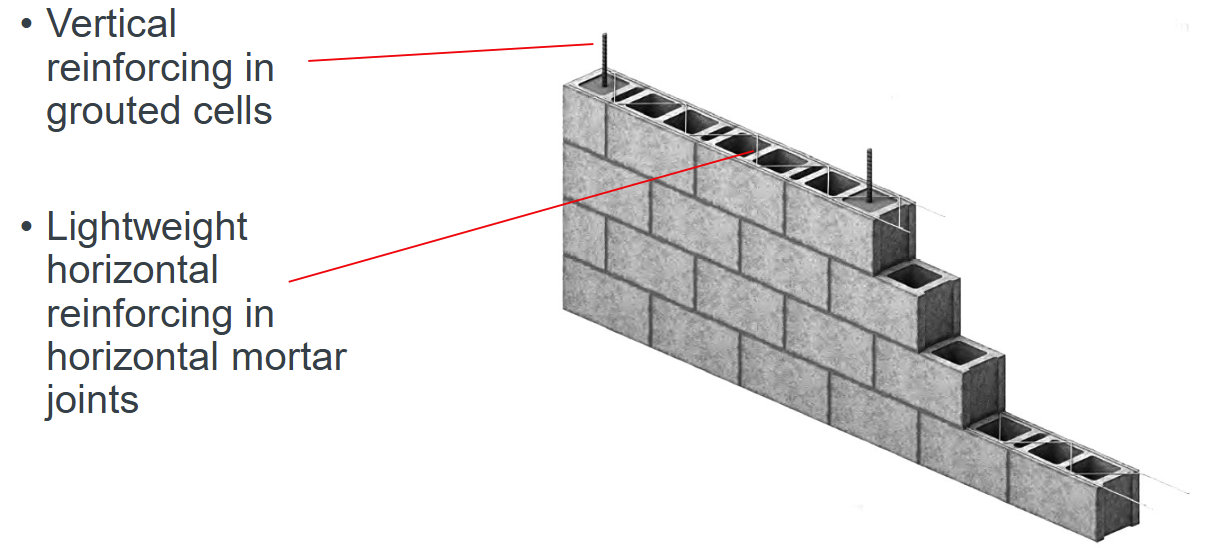masonry (stone & concrete)
1/19
There's no tags or description
Looks like no tags are added yet.
Name | Mastery | Learn | Test | Matching | Spaced |
|---|
No study sessions yet.
20 Terms
commerical stone types
For commercial purposes, building stone is classified into six groups according to ASTM C199.
Granite
Limestone
Quartz-based
Slate
Marble
Other
Each group has different exposure
conditions, construction requirements
granite group
Igneous
Nonporous, strong, durable
Suitable for exposure to severe weathering, ground contact
limestone group
Sedimentary
Strength and porosity vary with density
Colors from white, to gray, to red
Normally has a textured finish; a few can be polished
quartz-based group
Sedimentary
Sandstone: from quartz deposits
Brownstone, and some varieties of bluestone are varieties of sandstone
slate group
Metamorphic
Derived from shales (mineral clays)
Dense, hard, nonabsorbent
Variety of colors
marble group
Metamorphic
Varies greatly in its physical properties and appearance
Many colors, frequently with extensive veining
Easily polished
other group
Travertine:
Partially-crystallized, patterned calcite
Chemically similar to limestone
Similar to marble in its physical properties
other types
Alabaster
Greenstone
Schist
Serpentine
Soapstone
quarrying
A long-bladed diamond saw, traveling on rails, makes deep, long cuts into the solid rock.
Closely-spaced horizontal holes are drilled into the vertical face of the rock to create a plane of weakness near the bottom of the saw cuts
Rubber bladders are inserted into the saw kerfs and inflated, causing the large slabs to fall away from the solid rock.
Steel wedges are driven into the separated slabs, to split them into smaller blocks
Blocks are labeled and stacked, ready for transporting to the mill
milling
Bandsawing & circular sawing
Planeing
And a variety of other shaping and surface finishing operations
Hand carving
stone masonry
Stone masonry: laid in mortar, self-carry all the weight of the wall
Rubble
Ashlar
Stone cladding: mechanically fasten/attached to a separate structural frame or walls.
Stones carry their own weight.
Most commonly set in mortar, like brick or CMU
Stone blocks carry own weight. CMU
backup wall with anchors provides lateral
support.
rubble masonry
Unsquared stone blocks
Random: Laid without continuous horizontal joints
Coursed: Laid with continuous horizontal joints
ashlar masonry
Squared blocks
Random or coursed
stone cladding or curtain wall
Stone panels mechanically attached to building frame
Attachment system carries the weight of the panels
concrete masonry units (cmus)
Stiff concrete mix pressed into metal molds
Steam curing in autoclaves accelerates curing
Standard nominal size: 8" x 8" x 16"
Actual size is 3/8-inch less in each dimension
Can be manufactured in a great variety of shapes and sizes
dimensioning
Like brick masonry walls, concrete masonry wall dimensions should, as much as possible, conform to the dimensional module of the block, in this case 8 inches.
This minimizes the need to cut block or work with small pieces
laying cmu
Mortar is identical to that used for brick masonry
Corner leads are laid first.
String lines and levels are used to keep walls straight, plumb, and level
reinforcing
Reinforcing increases compressive strength, resistance to cracking and resist to lateral forces
Vertical steel reinforcing in a fully-grouted concrete block wall
Specially-shaped webs to accommodate both vertical and horizontal reinforcing bars without modification

spanning openings
Structural steel
Steel reinforced concrete block
Precast concrete
decorative or architectural units
Split-face block
Two or more blocks are cast as a single unit.
During the curing process, the blocks are split with knife-like blades
Ground-face block
After curing, block surface is ground smooth, creating a polished surface.
In any architectural block, the color of aggregates and cement can also be varied
Glazed block
Glass block